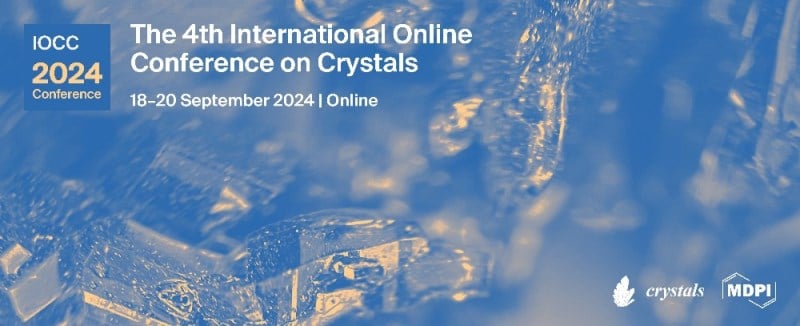-
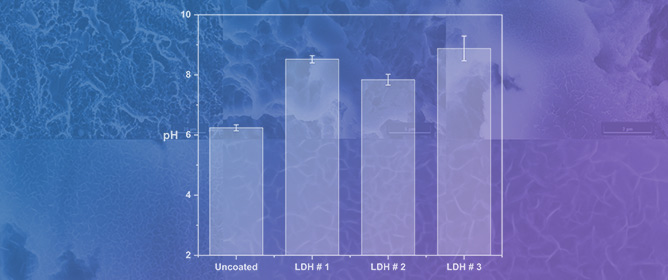 In Situ Growth of Mg-Fe Layered Double Hydroxides (LDH) Film on Titanium Dental Implant Substrates for pH Regulation in Oral Environments
In Situ Growth of Mg-Fe Layered Double Hydroxides (LDH) Film on Titanium Dental Implant Substrates for pH Regulation in Oral Environments -
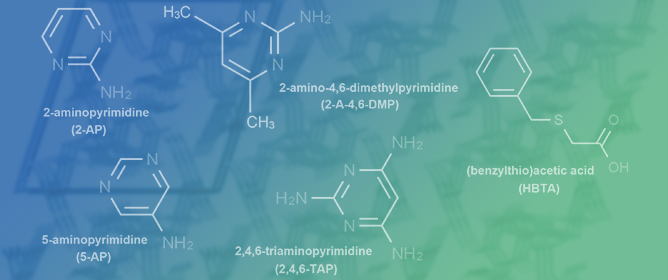 Neutral and Ionic Form of (Benzylthio)Acetic Acid in Novel Aminopyrimidine Based Multi-Component Crystalline Phases
Neutral and Ionic Form of (Benzylthio)Acetic Acid in Novel Aminopyrimidine Based Multi-Component Crystalline Phases -
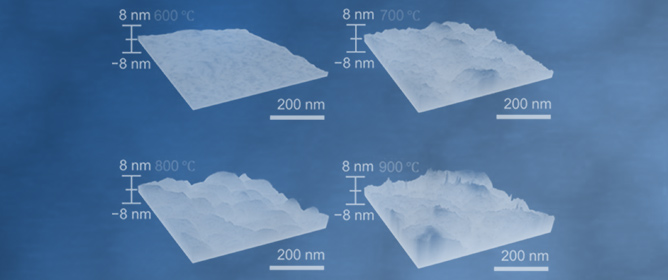 Optimization of a LaNiO3 Bottom Electrode for Flexible Pb(Zr,Ti)O3 Film-Based Ferroelectric Random Access Memory Applications
Optimization of a LaNiO3 Bottom Electrode for Flexible Pb(Zr,Ti)O3 Film-Based Ferroelectric Random Access Memory Applications
Journal Description
Crystals
Crystals
is an international, peer-reviewed, open access journal on Crystallography published monthly online by MDPI. The Professional Committee of Key Materials and Technology for Electronic Components (PC-KMTEC) is affiliated with Crystals and its members receive discounts on the article processing charges.
- Open Access— free for readers, with article processing charges (APC) paid by authors or their institutions.
- High Visibility: indexed within Scopus, SCIE (Web of Science), Inspec, CAPlus / SciFinder, and other databases.
- Journal Rank: JCR - Q2 (Crystallography) / CiteScore - Q2 (Condensed Matter Physics)
- Rapid Publication: manuscripts are peer-reviewed and a first decision is provided to authors approximately 10.6 days after submission; acceptance to publication is undertaken in 2.7 days (median values for papers published in this journal in the second half of 2023).
- Recognition of Reviewers: reviewers who provide timely, thorough peer-review reports receive vouchers entitling them to a discount on the APC of their next publication in any MDPI journal, in appreciation of the work done.
Impact Factor:
2.7 (2022);
5-Year Impact Factor:
2.6 (2022)
Latest Articles
Microstructure and Mechanical Properties of TiC/WC-Reinforced AlCoCrFeNi High-Entropy Alloys Prepared by Laser Cladding
Crystals 2024, 14(1), 83; https://doi.org/10.3390/cryst14010083 (registering DOI) - 15 Jan 2024
Abstract
By employing the technology of laser cladding, AlCoCrFeNi–TiC20−x/WCx high-entropy alloy coatings (where x = 0, 5, 10, 15, and 20 is the mass fraction) were fabricated on 316L stainless steel (316Lss). The effects of changes in different mass fractions
[...] Read more.
By employing the technology of laser cladding, AlCoCrFeNi–TiC20−x/WCx high-entropy alloy coatings (where x = 0, 5, 10, 15, and 20 is the mass fraction) were fabricated on 316L stainless steel (316Lss). The effects of changes in different mass fractions on the morphology, phase composition, microstructure, microhardness, and corrosion resistance of the composite coatings were studied. This demonstrates that the addition of TiC and WC powder produces an FCC phase in the original BCC phase, the morphology and size of the coatings from top to bottom undergo some changes with x, and the grain size evolution follows a cooling rate law. The evolution of microhardness and corrosion resistance of the coatings exhibit a trend of increasing first and then decreasing with an increase in x. The coatings exhibited their best microhardness and corrosion resistance when x = 15, and their corrosion resistance and microhardness were much better than those of the substrate.
Full article
(This article belongs to the Special Issue Additive Manufacturing (AM) for Advanced Materials and Structures: Green and Intelligent Development Trend Volume II)
►
Show Figures
Open AccessArticle
Synthesis and Characterization of Indium-Doped SnO2-Based Impedance Spectroscopy Sensor for Real-Time Humidity Sensing Applications
Crystals 2024, 14(1), 82; https://doi.org/10.3390/cryst14010082 - 15 Jan 2024
Abstract
Metallic transition-metal dichalcogenides are emerging as promising electrode materials for applications such as 2D electronic devices owing to their good electrical conductivity. In this study, a high-performance humidity sensor based on NbTe2 electrode material and an indium-doped SnO2 thin film sensing
[...] Read more.
Metallic transition-metal dichalcogenides are emerging as promising electrode materials for applications such as 2D electronic devices owing to their good electrical conductivity. In this study, a high-performance humidity sensor based on NbTe2 electrode material and an indium-doped SnO2 thin film sensing layer was fabricated using a pulsed laser deposition system. The morphology, structural, elemental compositions, and electrical properties of the as-deposited samples were characterized. Additionally, the humidity sensing response of the fabricated sensor with In-doped SnO2 (8:92 wt%) sensing film was evaluated in a wide range of relative humidity at room temperature. The results demonstrated that the humidity sensor based on In-doped SnO2 exhibited a high sensitivity of 103.1 Ω/%RH, fast response and recovery times, a low hysteresis value, good linearity, and repeatability. In addition, the sensor had good long-term stability, with a variation in impedance of less than 3%. The results indicated that the humidity sensor could be suitable for practical humidity sensing applications.
Full article
(This article belongs to the Section Inorganic Crystalline Materials)
►▼
Show Figures
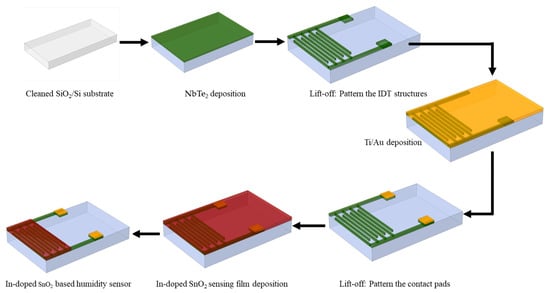
Figure 1
Open AccessArticle
Microstructural and Hall–Petch Analysis of Additively Manufactured Ferritic Alloy Using 2507 Duplex Stainless Steel Powder
Crystals 2024, 14(1), 81; https://doi.org/10.3390/cryst14010081 - 15 Jan 2024
Abstract
The powder bed fusion–laser beam (PBF-LB) process, a method of additive manufacturing (AM), was used to print duplex stainless steel (DSS) using commercial-grade 2507 powders. While conventionally processed DSS has a two-phase microstructure consisting of 50% austenite and 50% ferrite, the PBF-LB-printed 2507
[...] Read more.
The powder bed fusion–laser beam (PBF-LB) process, a method of additive manufacturing (AM), was used to print duplex stainless steel (DSS) using commercial-grade 2507 powders. While conventionally processed DSS has a two-phase microstructure consisting of 50% austenite and 50% ferrite, the PBF-LB-printed 2507 alloy was nearly 100% ferrite. Optimal processing conditions that minimized porosity were determined to be 290 W laser power and 1000 mm/s scan speed, and grain size, texture, and phases were characterized as a function of laser power and scan speed. Grain size increased with increasing laser power but decreased with increasing scan speed. A <100> texture diminished with increasing scan speed from 1000 mm/s to 1400 mm/s. No austenite phase was detected. Transmission electron microscopy (TEM) and scanning transmission electron microscopy (STEM) characterization revealed nanoscale chromium nitride precipitates in the ferritic matrix (incoherent hexagonal close-packed (HCP) precipitates at grain boundaries and coherent body-centered cubic (BCC) precipitates within the grains) and a high density of tangled dislocations. Tensile tests of as-printed alloys showed a yield strength of 570 MPa, an ultimate tensile strength of 756 MPa, and an elongation to failure of 10%. The tensile properties were analyzed based on the observed microstructure considering grain size, nanoscale precipitates, and the high density of dislocations.
Full article
(This article belongs to the Section Crystalline Metals and Alloys)
►▼
Show Figures
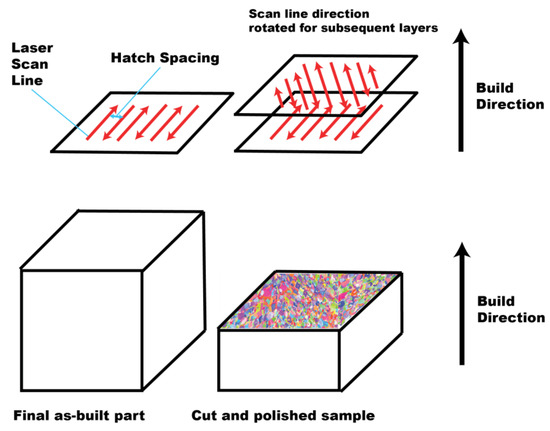
Figure 1
Open AccessArticle
Gemological and Chemical Characterization of Gem-Quality Titanite from Morocco
Crystals 2024, 14(1), 80; https://doi.org/10.3390/cryst14010080 - 14 Jan 2024
Abstract
Titanite is a widespread accessory mineral in igneous, metamorphic, and hydrothermal rocks, but few comply with gem-grade requirements. Previous studies on Moroccan titanite focused on elementary composition and U-Pb dating. In this study, two gem-grade titanites (MA-1 and MA-2) from the Moroccan Central
[...] Read more.
Titanite is a widespread accessory mineral in igneous, metamorphic, and hydrothermal rocks, but few comply with gem-grade requirements. Previous studies on Moroccan titanite focused on elementary composition and U-Pb dating. In this study, two gem-grade titanites (MA-1 and MA-2) from the Moroccan Central High Atlas were investigated through gemological and chemical studies, including infrared spectrum, Raman spectrum, SEM-EDS, and LA-ICP-MS. Two titanite samples are yellow, transparent–translucent with a greasy luster, 3.5 and 2.5 mm long. MA-1 and MA-2 have similar gemological properties, the refractive index (RI) is beyond the range of the refractometer (>1.78), the specific gravity (SG) values fall in the range of 3.52~3.54 and both are inert to short-wave and long-wave UV radiation. The spectral characteristics have high consistency with the RRUFF database. The major elements’ composition shows a negative correlation between Al, Fe, V, and Ti, suggesting the titanites underwent substitutions such as (Al, Fe3+) + (F, OH) ↔ Ti + O. The titanite samples, characterized by a low abundance of REE (802~4088 ppm) and enriched in LREE, exhibit positive Eu (δEu: 1.53~7.79) and Ce (δCe: 1.08~1.33) anomalies, indicating their formation in a hydrothermal environment with low oxygen fugacity. The 238U/206Pb and 207Pb/206Pb ratios of the titanites yield lower intercept ages of 152.6 ± 2.2 and 151.4 ± 5.3 Ma (1s), consistent with their weighted average 206Pb/238U ages of 152.3 ± 2.0 and 150.7 ± 3.2 Ma (1s) respectively. The results of U-Pb dating are matched with the second main magmatic activities in the High Atlas intracontinental belt of Morocco during the Mesozoic to Cenozoic period. Moreover, the two titanite samples have almost no radiational damage. All the results show that the titanite from High Atlas, Morocco, has the potential to be a reference material for LA-ICP-MS U–Pb dating, but further experiments are needed to be sure.
Full article
(This article belongs to the Section Mineralogical Crystallography and Biomineralization)
►▼
Show Figures
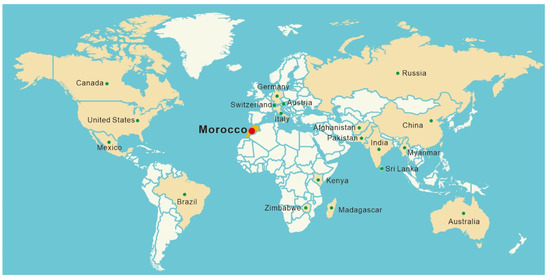
Figure 1
Open AccessArticle
A Self-Powered Broadband Photodetector with High Photocurrent Based on Ferroelectric Thin Film Using Energy Band Structure Design
by
, , , , , , , and
Crystals 2024, 14(1), 79; https://doi.org/10.3390/cryst14010079 - 13 Jan 2024
Abstract
Self-powered photodetectors have the advantages of high sensitivity, sustainability, and small size and have become a research hotspot in advanced optoelectronic systems. However, the low output photocurrent density seriously hinders the practical application of ferroelectric self-powered photodetectors. Herein, the high-efficiency photoelectric detection performance
[...] Read more.
Self-powered photodetectors have the advantages of high sensitivity, sustainability, and small size and have become a research hotspot in advanced optoelectronic systems. However, the low output photocurrent density seriously hinders the practical application of ferroelectric self-powered photodetectors. Herein, the high-efficiency photoelectric detection performance of the Bi1-xHoxFeO3 ferroelectric self-powered photodetector is realized by doping Ho. The responsivity (R) and detectivity (
(This article belongs to the Special Issue Ferroelectric and Multiferroic Thin Films)
►▼
Show Figures
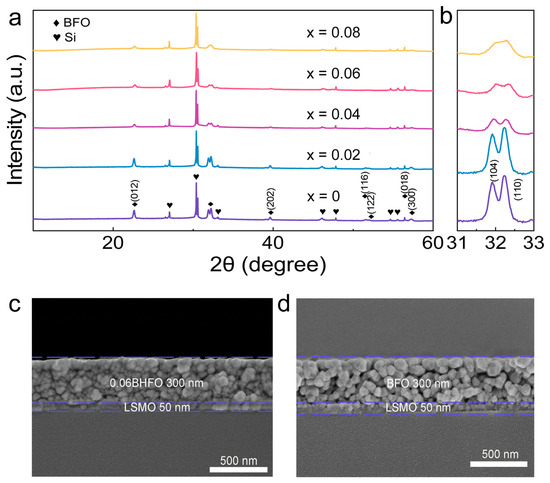
Figure 1
Open AccessArticle
Analysis of the Effect of Copper Doping on the Optoelectronic Properties of Indium Oxide Thin Films and the Thermoelectric Properties of an In2O3/Pt Thermocouple
Crystals 2024, 14(1), 78; https://doi.org/10.3390/cryst14010078 - 13 Jan 2024
Abstract
The detection and real-time monitoring of temperature parameters are important, and indium oxide-based thin film thermocouples can be integrated on the surface of heaters because they operate normally under harsh conditions and provide accurate online temperature monitoring. The higher stability and appropriate optical
[...] Read more.
The detection and real-time monitoring of temperature parameters are important, and indium oxide-based thin film thermocouples can be integrated on the surface of heaters because they operate normally under harsh conditions and provide accurate online temperature monitoring. The higher stability and appropriate optical and electrical properties of In2O3 make it very suitable as an electrode material for thermocouple sensors. This work demonstrates that copper doping can alter the optical and electrical properties of In2O3 films and regulate the output performance of thermocouples. Copper-doped In2O3 thin films were prepared using the magnetron co-sputtering method. The doping concentration of Cu was controlled using direct current (DC) power. An In2O3/Pt thermocouple sensor was prepared, and the optoelectronic and thermocouple properties were adjusted by changing the copper doping content. The thickness valve of the thin film sample was 300 nm. The results of the X-ray diffraction suggested that the structure of the doped In2O3 thin films was cubic. The results of the energy-dispersive X-ray analysis revealed that Cu was doped into the In2O3 thin films. All deposited films were n-type semiconductor materials according to Hall effect testing. The 4.09 at% Cu-doped thin films possessed the highest resistivity (30.2 × 10−3 Ω·cm), a larger carrier concentration (3.72 × 1020 cm−3), and the lowest carrier mobility (0.56 cm2V−1s−1). The optical band gap decreased from 3.76 to 2.71 eV with an increase in the doping concentration, and the transmittance of the film significantly reduced. When the DC power was increased, the variation range of Seebeck coefficient for the In2O3/Pt thermocouple was 152.1–170.5 μV/°C, and the range of thermal output value was 91.4–102.4 mV.
Full article
(This article belongs to the Special Issue Wide-Bandgap Semiconductor Materials, Devices and Systems)
►▼
Show Figures
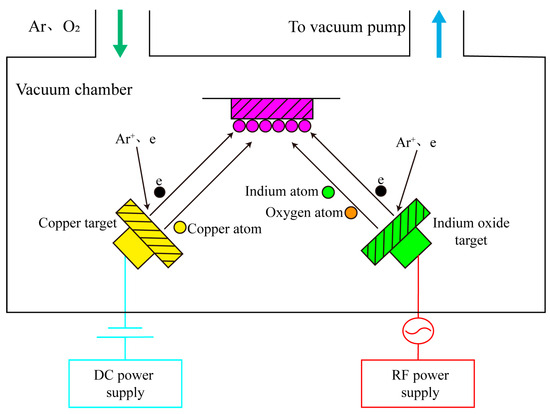
Figure 1
Open AccessReview
Crystal Engineering of Hydrogen Bonding for Direct Air Capture of CO2: A Quantum Crystallography Perspective
by
and
Crystals 2024, 14(1), 77; https://doi.org/10.3390/cryst14010077 - 13 Jan 2024
Abstract
►▼
Show Figures
Rising atmospheric CO2 levels demand efficient and sustainable carbon capture solutions. Direct air capture (DAC) via crystallizing hydrogen-bonded frameworks such as carbonate salts has emerged as a promising approach. This review explores the potential of crystal engineering, in tandem with advanced quantum
[...] Read more.
Rising atmospheric CO2 levels demand efficient and sustainable carbon capture solutions. Direct air capture (DAC) via crystallizing hydrogen-bonded frameworks such as carbonate salts has emerged as a promising approach. This review explores the potential of crystal engineering, in tandem with advanced quantum crystallography techniques and computational modeling, to unlock the full potential of DAC materials. We examine the critical role of hydrogen bonding and other noncovalent interactions within a family of bis-guanidines that governs the formation of carbonate salts with high CO2 capture capacity and low regeneration energies for utilization. Quantum crystallography and charge density analysis prove instrumental in elucidating these interactions. A case study of a highly insoluble carbonate salt of a 2,6-pyridine-bis-(iminoguanidine) exemplifies the effectiveness of these approaches. However, challenges remain in the systematic and precise determination of hydrogen atom positions and atomic displacement parameters within DAC materials using quantum crystallography, and limitations persist in the accuracy of current energy estimation models for hydrogen bonding interactions. Future directions lie in exploring diverse functional groups, designing advanced hydrogen-bonded frameworks, and seamlessly integrating experimental and computational modeling with machine learning. This synergistic approach promises to propel the design and optimization of DAC materials, paving the way for a more sustainable future.
Full article
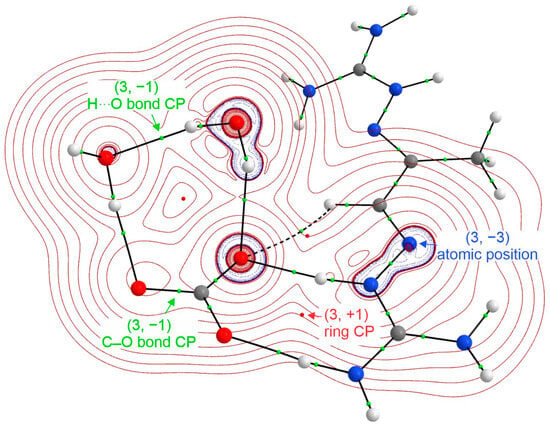
Figure 1
Open AccessArticle
Cobalt(II) Paddle-Wheel Complex with 3,5-Di(tert-butyl)-4-hydroxybenzoate Bridges: DFT and ab initio Calculations, Magnetic Dilution, and Magnetic Properties
by
, , , , , , , , , , , , , and
Crystals 2024, 14(1), 76; https://doi.org/10.3390/cryst14010076 - 13 Jan 2024
Abstract
A new binuclear "paddle-wheel" complex, [Co2(bhbz)4(EtOH)2]·4EtOH (1, Hbhbz-3,5-di(tert-butyl)-4-hydroxybenzoic acid); an isostructural zinc complex (2); a and magnetically diluted sample of [Zn1.93Co0.07(bhbz)4(EtOH)2]·4EtOH (3
[...] Read more.
A new binuclear "paddle-wheel" complex, [Co2(bhbz)4(EtOH)2]·4EtOH (1, Hbhbz-3,5-di(tert-butyl)-4-hydroxybenzoic acid); an isostructural zinc complex (2); a and magnetically diluted sample of [Zn1.93Co0.07(bhbz)4(EtOH)2]·4EtOH (3) were obtained. Molecular structures of 1 and 2 were determined by single-crystal X-ray diffraction. DFT calculations for 1 indicate strong Co-Co antiferromagnetic exchange interactions in the binuclear fragment. It was shown that when one paramagnetic ion in the binuclear molecule is replaced by a diamagnetic zinc(II) ion, the remaining cobalt(II) ion can be considered as an isolated center with magnetic anisotropy, the parameters of which are determined by ab initio calculations. Magnetic properties for samples 1 and 3 were investigated and analyzed in detail.
Full article
(This article belongs to the Special Issue Fabrication and Properties of Magnetic Materials)
►▼
Show Figures
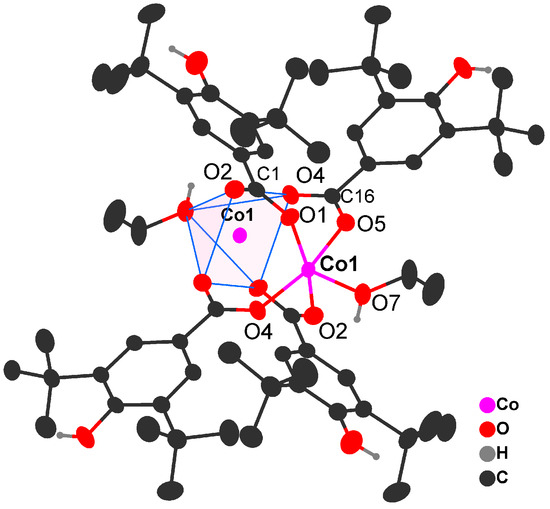
Figure 1
Open AccessArticle
Hot-Electron Microwave Noise and Energy Relaxation in (Be)MgZnO/ZnO Heterostructures
by
, , , , and
Crystals 2024, 14(1), 75; https://doi.org/10.3390/cryst14010075 - 12 Jan 2024
Abstract
Pulsed hot-electron microwave noise measurements of the (Be)MgZnO/ZnO heterostructures are presented in this work. The heterostructures of different barrier thicknesses and different bulk electron densities in ZnO layer are compared. Capacitance–voltage (C–V) measurements reveal the decrease in the two-dimensional electron gas (2DEG) peak
[...] Read more.
Pulsed hot-electron microwave noise measurements of the (Be)MgZnO/ZnO heterostructures are presented in this work. The heterostructures of different barrier thicknesses and different bulk electron densities in ZnO layer are compared. Capacitance–voltage (C–V) measurements reveal the decrease in the two-dimensional electron gas (2DEG) peak in electron density profile at the Zn-polar BeMgZnO/ZnO interface as the BeMgZnO barrier layer thickness decreases. For thin-barrier heterostructures, the peak disappears and only the bulk electron density is resolved in C–V measurements. The excess noise temperature at ∼10 GHz in thick-barrier heterostructures is noticeably higher (∼10 times) compared to thin-barrier heterostructures, which is attributed to the strong noise source in the contacts of the former. In the case of thin-barrier heterostructures, at electric fields above ∼10 kV/cm and electron density
(This article belongs to the Section Crystal Engineering)
►▼
Show Figures
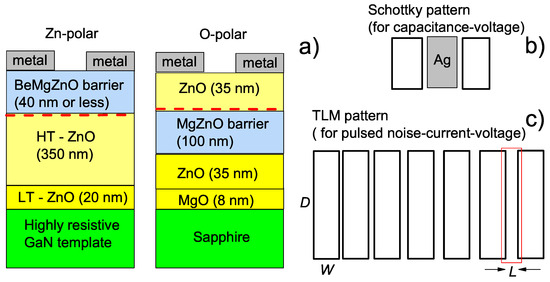
Figure 1
Open AccessArticle
Segregation of Phosphorus and Silicon at the Grain Boundary in Bcc Iron via Machine-Learned Force Fields
by
and
Crystals 2024, 14(1), 74; https://doi.org/10.3390/cryst14010074 - 12 Jan 2024
Abstract
The study of the effects of impurity on grain boundaries is a critical aspect of materials science, particularly when it comes to understanding and controlling the properties of materials for specific applications. One of the related key issues is the segregation preference of
[...] Read more.
The study of the effects of impurity on grain boundaries is a critical aspect of materials science, particularly when it comes to understanding and controlling the properties of materials for specific applications. One of the related key issues is the segregation preference of impurity atoms in the grain boundary region. In this paper, we employed the on-the-fly machine learning to generate force fields, which were subsequently used to calculate the segregation energies of phosphorus and silicon in bcc iron containing the ∑5(310)[001] grain boundary. The generated force fields were successfully benchmarked using ab initio data. Our further calculations considered impurity atoms at a number of possible interstitial and substitutional segregation sites. Our predictions of the preferred sites agree with the experimental observations. Planar concentration of impurity atoms affects the segregation energy and, moreover, can change the preferred segregation sites.
Full article
(This article belongs to the Section Crystalline Metals and Alloys)
►▼
Show Figures

Figure 1
Open AccessArticle
Study of Multi-Channel Mode-Division Multiplexing Based on a Chalcogenide-Lithium Niobate Platform
Crystals 2024, 14(1), 73; https://doi.org/10.3390/cryst14010073 - 11 Jan 2024
Abstract
A multi-channel mode-division multiplexing based on a chalcogenide-lithium niobate platform using chalcogenide films with adjustable refractive index is proposed, with the aim of overcoming issues with narrow bandwidth and large crosstalk in conventional multiplexers. An asymmetric directional coupler, employing chalcogenide-based thin-film modulation, was
[...] Read more.
A multi-channel mode-division multiplexing based on a chalcogenide-lithium niobate platform using chalcogenide films with adjustable refractive index is proposed, with the aim of overcoming issues with narrow bandwidth and large crosstalk in conventional multiplexers. An asymmetric directional coupler, employing chalcogenide-based thin-film modulation, was designed to realize the multiplexing and separation of TE1, TE2, and TE3 modes. Simulations show that the device is capable of obtaining an insertion loss of between 0.03 dB and 0.7 dB and a crosstalk of between −21.66 dB and −28.71 dB at 1550 nm. The crosstalk of the TE1, TE2, and TE3 modes is below −20.1 dB when accessing the waveguide output port in the 1500–1600 nm band. The proposed multiplexer is a promising approach to enhance the transmission capability of thin-film lithium-niobate-integrated optical paths.
Full article
(This article belongs to the Topic Optoelectronic Materials, 2nd Volume)
►▼
Show Figures
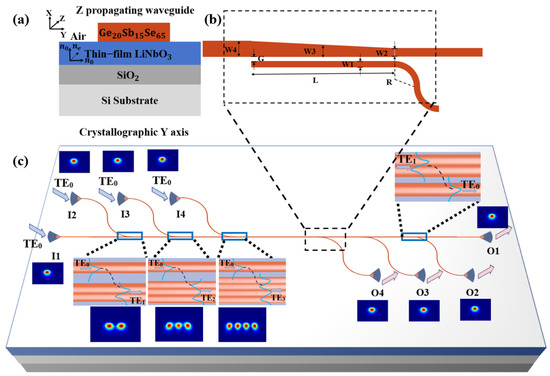
Figure 1
Open AccessArticle
Numerical Simulation of CdTe Crystal Growth Using the Vertical Gradient Freeze Technique Assisted by Axial Low-Frequency Oscillations of the Melt
by
, , , , and
Crystals 2024, 14(1), 72; https://doi.org/10.3390/cryst14010072 - 11 Jan 2024
Abstract
The problem of intensification of the melt crystal growth process has been analyzed using CdTe as an actual material. Numerical simulation of 100 mm diameter CdTe crystal growth using the VGF technique has been carried out. The heat–mass transfer was controlled by introducing
[...] Read more.
The problem of intensification of the melt crystal growth process has been analyzed using CdTe as an actual material. Numerical simulation of 100 mm diameter CdTe crystal growth using the VGF technique has been carried out. The heat–mass transfer was controlled by introducing low-frequency oscillating baffle into the melt, which is a so-called axial vibrational control (AVC) technique. The baffle configuration has been optimized to destroy solid “tails”, which were formed near the crucible walls at high cooling rates due to the low thermoconductivity and the corresponding latent heat. Analysis of CdTe homogeneity range showed that during fast crystal cooling, Te micro precipitations were formed, resulting from the decay of oversaturated Cd-rich nonstoichiometric solid solution during the Bridgman crystal growth technique. After full crystallization, a VGF-grown CdTe crystal stays inside the phase field of the high-temperature wurtzite polymorph. This makes it possible to go through the polymorph transition without Te micro-precipitating using the advantages of the VGF-specific feature of very slow cooling.
Full article
(This article belongs to the Section Crystal Engineering)
►▼
Show Figures
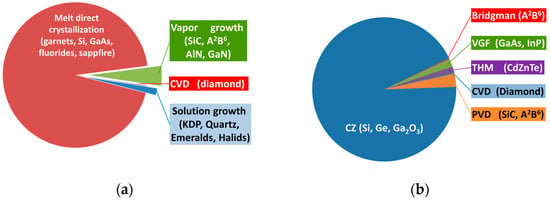
Figure 1
Open AccessArticle
The Solid-Phase Transition of Carbapenem CS-023 Polymorphs and the Change in Helicity Observed in the Transition
Crystals 2024, 14(1), 71; https://doi.org/10.3390/cryst14010071 - 11 Jan 2024
Abstract
►▼
Show Figures
Anti-solvent crystallization of carbapenem CS-023 was performed at 25 °C. The following results were obtained: (1) A solvate crystal, Form A (5/2 Ethanol·1/2 H2O), was recovered from 80 v/v% ethanol solution; (2) Form A transformed to Form H
[...] Read more.
Anti-solvent crystallization of carbapenem CS-023 was performed at 25 °C. The following results were obtained: (1) A solvate crystal, Form A (5/2 Ethanol·1/2 H2O), was recovered from 80 v/v% ethanol solution; (2) Form A transformed to Form H (4H2O) through solid-phase transition through the solvate-free polymorph, Form A-2, and Form A also transformed into Form C (1Ethanol·3H2O) through solvent-mediated transformation. In the present study, we found that Form C also transforms to Form H through the solid-phase transition through the solvate-free polymorph Form C-2. The three polymorphs, Forms A, H, and C, were composed of helical chain structures. However, there was an incomprehensible affair in the solid-phase transition among the three polymorphs. Namely, Form A comprised a left-handed helix. On the other hand, Form C’s and Form H’s helix chains were in a left- and right-handed helix complex, respectively. The solid-phase transition of Form A into Form H suggested a switch in helicity in the solid. We attempted to explain the helicity change in the solid-phase transition. As a result, we suggest that the over-absorption of water by Form A-2 at high humidity plays a vital role in the helicity change.
Full article
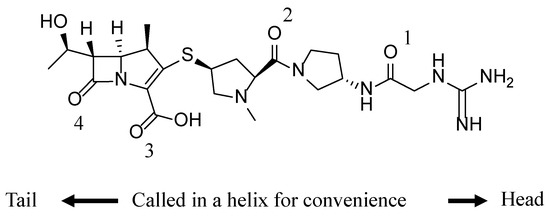
Figure 1
Open AccessArticle
Analysis and Mechanism Study of Residual Stress during the Spontaneous Crystallisation Process of Molten Titanium-Containing Blast Furnace Slag
Crystals 2024, 14(1), 70; https://doi.org/10.3390/cryst14010070 - 10 Jan 2024
Abstract
Molten titanium-containing blast furnace slag can be used to obtain cast stone materials by controlling a reasonable heat treatment system. The material acquired during this process showcases residual stress, which additionally impacts the macroscopic characteristics of the material. This article simulates the process
[...] Read more.
Molten titanium-containing blast furnace slag can be used to obtain cast stone materials by controlling a reasonable heat treatment system. The material acquired during this process showcases residual stress, which additionally impacts the macroscopic characteristics of the material. This article simulates the process of manufacturing microcrystalline cast stones based on the self-crystallisation ability of titanium-containing products. This research employs X-ray diffraction to precisely and conveniently assess the residual stress of microcrystalline cast stones and investigates how viscosity and the thermal expansion coefficient influence the residual stress level. The study provides a theoretical foundation for explaining titanium-containing blast furnace slag and combines characterisation methods such as XRD (X-ray diffraction), SEM (Scanning electron microscope), DTA (Differential thermal analysis), and theoretical calculations such as Factpage and Fullprop to study the effect of the TiO2 content on the microstructure of self-crystallised mechanical characteristics of microcrystalline cast stones through residual stress. The results of the experiment indicate that as the TiO2 content in the system increases, the glass phase is reduced, the crystallinity improves, and the main crystal phase changes from a feldspar phase to a diopside phase. Furthermore, its viscosity, thermal expansion coefficient, and residual stress decrease while its corresponding compressive strength and bending strength increase.
Full article
(This article belongs to the Special Issue Nondestructive Characterization and Evaluation of Crystalline Materials)
►▼
Show Figures

Figure 1
Open AccessReview
Transistor-Based Synaptic Devices for Neuromorphic Computing
Crystals 2024, 14(1), 69; https://doi.org/10.3390/cryst14010069 - 09 Jan 2024
Abstract
Currently, neuromorphic computing is regarded as the most efficient way to solve the von Neumann bottleneck. Transistor-based devices have been considered suitable for emulating synaptic functions in neuromorphic computing due to their synergistic control capabilities on synaptic weight changes. Various low-dimensional inorganic materials
[...] Read more.
Currently, neuromorphic computing is regarded as the most efficient way to solve the von Neumann bottleneck. Transistor-based devices have been considered suitable for emulating synaptic functions in neuromorphic computing due to their synergistic control capabilities on synaptic weight changes. Various low-dimensional inorganic materials such as silicon nanomembranes, carbon nanotubes, nanoscale metal oxides, and two-dimensional materials are employed to fabricate transistor-based synaptic devices. Although these transistor-based synaptic devices have progressed in terms of mimicking synaptic functions, their application in neuromorphic computing is still in its early stage. In this review, transistor-based synaptic devices are analyzed by categorizing them into different working mechanisms, and the device fabrication processes and synaptic properties are discussed. Future efforts that could be beneficial to the development of transistor-based synaptic devices in neuromorphic computing are proposed.
Full article
(This article belongs to the Special Issue Advances in Low-Dimensional Materials for Electronics and Sensing Applications)
►▼
Show Figures
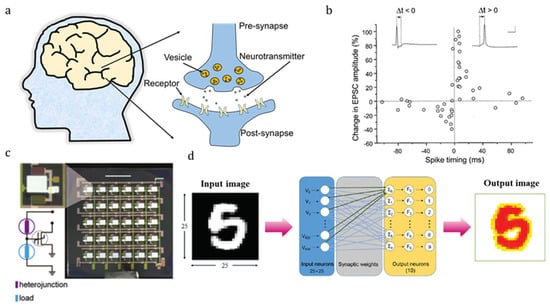
Figure 1
Open AccessArticle
Solution-Processed Monolithic Tandem Perovskite/n-Si Hybrid Solar Cells Using MoO3/InZnO Bilayer-Based Interconnecting and Window Layers
Crystals 2024, 14(1), 68; https://doi.org/10.3390/cryst14010068 - 08 Jan 2024
Abstract
A metal oxide-based interconnecting and window layer consisting of a molybdenum oxide (MoO3)/Zn-doped In2O3 (IZO) bilayer was investigated in efficient solution-processed perovskite/n-Si monolithic tandem solar cells using formamidinium cesium lead triiodide, FA0.9Cs0.1PbI3,
[...] Read more.
A metal oxide-based interconnecting and window layer consisting of a molybdenum oxide (MoO3)/Zn-doped In2O3 (IZO) bilayer was investigated in efficient solution-processed perovskite/n-Si monolithic tandem solar cells using formamidinium cesium lead triiodide, FA0.9Cs0.1PbI3, and poly(3,4-ethylenedioxythiophene)/poly(polystyrene sulfonate) (PEDOT:PSS). The MoO3/IZO bilayer with and without Au nanoparticle play a significant role in the charge extraction and recombination within the interconnecting layer and the window layer of the top cell, respectively. A power conversion efficiency of 18–19% was achieved with a short-circuit current, Jsc, of 17.8 mA/cm2; an open-circuit voltage, Voc, of 1.48 V; and an FF of 0.74 by adjusting the layer thicknesses of MoO3 (5 nm), Au nanoparticle layer (5 nm), and sputtered IZO (42 nm for ICL and 80 nm for window layer).
Full article
(This article belongs to the Topic Surface and Interface Engineering in Catalytic and Optoelectronic Applications)
►▼
Show Figures
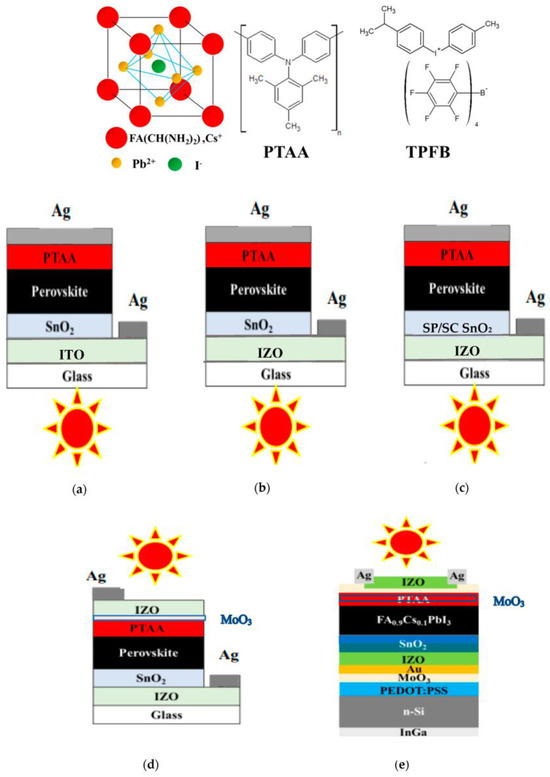
Figure 1
Open AccessArticle
Synthesis, Crystal Structure and Photoluminescent Properties of Novel 9-Cyano-Pyrrolo[1,2-a][1,10]Phenanthrolines
by
, , , , , , , and
Crystals 2024, 14(1), 67; https://doi.org/10.3390/cryst14010067 - 07 Jan 2024
Abstract
Novel 9-cyano-pyrrolo[1,2-a][1,10]phenanthrolines 6a–d were obtained by an efficient one-pot regioselective reaction between 1,10-phenanthrolinium bromides 2a–d and acrylonitrile as a dipolarophile, in the presence of triethylamine and tetrakis-pyridino-cobalt(II) dichromate (TPCD) as oxidizing agents. The optical properties of the
[...] Read more.
Novel 9-cyano-pyrrolo[1,2-a][1,10]phenanthrolines 6a–d were obtained by an efficient one-pot regioselective reaction between 1,10-phenanthrolinium bromides 2a–d and acrylonitrile as a dipolarophile, in the presence of triethylamine and tetrakis-pyridino-cobalt(II) dichromate (TPCD) as oxidizing agents. The optical properties of the compounds were investigated through UV–Vis spectrophotometry and steady-state photoluminescence measurements, while their structures were elucidated by single-crystal X-ray diffraction. The structural characterization revealed that the molecular structures of the four compounds were stabilized by hydrogen bonds and π–π interactions.
Full article
(This article belongs to the Special Issue Characterisation and Study of Compounds by Single Crystal X-ray Diffraction)
►▼
Show Figures
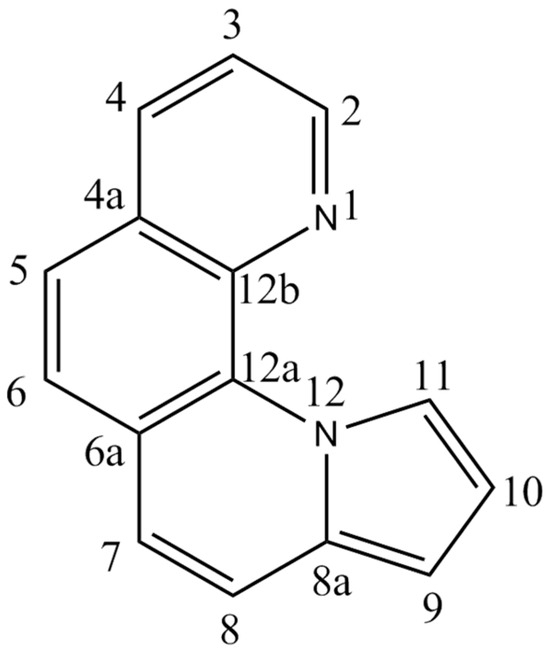
Figure 1
Open AccessArticle
Monitoring of Carbonated Hydroxyapatite Growth on Modified Polycrystalline CVD-Diamond Coatings on Titanium Substrates
Crystals 2024, 14(1), 66; https://doi.org/10.3390/cryst14010066 - 06 Jan 2024
Abstract
Production of diamond coatings on titanium substrates has demonstrated as a promising strategy for applications ranging from biosensing to hard tissue engineering. The present study focuses on monitoring the nucleation and growth of bone-like carbonated-hydroxyapatite (C-HA) on polycrystalline diamond (PCD) synthetized on titanium
[...] Read more.
Production of diamond coatings on titanium substrates has demonstrated as a promising strategy for applications ranging from biosensing to hard tissue engineering. The present study focuses on monitoring the nucleation and growth of bone-like carbonated-hydroxyapatite (C-HA) on polycrystalline diamond (PCD) synthetized on titanium substrate by means of a hot filament chemical vapor deposition (HF-CVD) method. The surface terminations of diamond coatings were selectively modified by oxidative treatments. The process of the C-HA deposition, accomplished by precipitation from simulated body fluid (SBF), was monitored from 3 to 20 days by Raman spectroscopy analysis. The coupling of morphological and structural investigations suggests that the modulation of the PCD surface chemistry enhances the bioactivity of the produced materials, allowing for the formation of continuous C-HA coatings with needle-like texture and chemical composition typical of those of the bone mineral. Specifically, after 20 days of immersion in SBF the calculated carbonate weight percent and the Ca/P ratio are 5.5% and 2.1, respectively. Based on these results, this study brings a novelty in tailoring the CVD-diamond properties for advanced biomedical and technological applications.
Full article
(This article belongs to the Special Issue Poly-Crystalline/Single-Crystalline Diamonds)
►▼
Show Figures
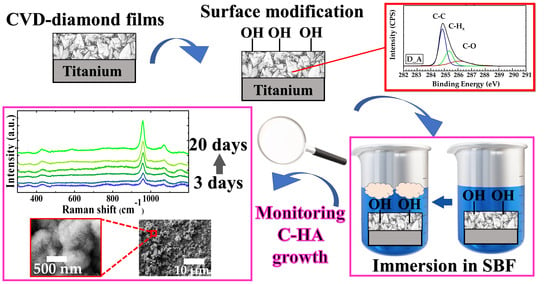
Graphical abstract
Open AccessArticle
ZnO-Au Hybrid Metamaterial Thin Films with Tunable Optical Properties
by
, , , , , , , , , and
Crystals 2024, 14(1), 65; https://doi.org/10.3390/cryst14010065 - 06 Jan 2024
Abstract
ZnO-Au nanocomposite thin films have been previously reported as hybrid metamaterials with unique optical properties such as plasmonic resonance properties and hyperbolic behaviors. In this study, Au composition in the ZnO-Au nanocomposites has been effectively tuned by target composition variation and thus resulted
[...] Read more.
ZnO-Au nanocomposite thin films have been previously reported as hybrid metamaterials with unique optical properties such as plasmonic resonance properties and hyperbolic behaviors. In this study, Au composition in the ZnO-Au nanocomposites has been effectively tuned by target composition variation and thus resulted in microstructure and optical property tuning. Specifically, all the ZnO-Au nanocomposite thin films grown through the pulsed laser deposition (PLD) method show obvious vertically aligned nanocomposite (VAN) structure with the Au nanopillars embedded in the ZnO matrix. Moreover, the average diameter of Au nanopillars increases as Au concentration increases, which also leads to the redshifts in the surface plasmon resonance (SPR) wavelength and changes in the hyperbolic behaviors of the films. As a whole, this work discusses how strain-driven tuning of optical properties and microstructure resulted through a novel Au concentration variation approach which has not been previously attempted in the ZnO-Au thin film system. These highly ordered films present great promise in the areas of sensing, waveguides, and nanophotonics to name a few.
Full article
(This article belongs to the Special Issue Synthesis and Application of Nanocomposite Materials)
►▼
Show Figures
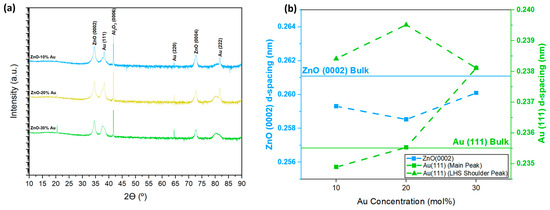
Figure 1
Open AccessArticle
Effects of Friction Stir Processing on the Microstructure and Mechanical Properties of an Ultralight Mg-Li Alloy
by
, , , , , , , and
Crystals 2024, 14(1), 64; https://doi.org/10.3390/cryst14010064 - 04 Jan 2024
Abstract
Magnesium–lithium alloys are arguably the lightest metal structural materials but have low strength. In order to increase strength, friction stir processing (FSP) is applied to a hot-rolled Mg-10Li-3Al-3Zn (LA103Z) sheet to study the effects on the microstructure and mechanical properties. In this study,
[...] Read more.
Magnesium–lithium alloys are arguably the lightest metal structural materials but have low strength. In order to increase strength, friction stir processing (FSP) is applied to a hot-rolled Mg-10Li-3Al-3Zn (LA103Z) sheet to study the effects on the microstructure and mechanical properties. In this study, the strengthening mechanisms of various FSP regions of an Mg-Li alloy were clarified by a combination of numerical simulation and experimental method. Based on ANSYS APDL, a finite element model with a moving heat source is established. Rotational speeds of 800, 1000, and 1200 rpm and traverse speeds of 100, 110, and 120 mm/min were used in this research. The simulation results confirm that the influence of the rotation speed on the alloy temperature field is greater than that of the travel speed. The temperature of the processing area increases with an increase in rotation speed and decreases with an increase in travel speed. Then, hot-rolled LA103Z alloy plates are processed by FSP. The correspondence between the numerical simulation and experiment was verified by infrared thermography. The results indicate that FSP decreases the grain size significantly for the dynamic recrystallization and dramatic mechanical crushing of the stirring pin. The α-Mg and AlLi are solid soluted in the β-Li matrix. The tensile strength of the processing zone is 260.67 MPa (1000 rpm, 110 mm/min) versus the 170.47 MPa of the base metal. The SZ has the highest microhardness of 77.8 HV (800 rpm, 120 mm/min) and decreases gradually to the BM. The severe deformation, recrystallization, and solid solution of the α-Mg are important factors contributing to the improved mechanical properties.
Full article
(This article belongs to the Special Issue Progress in Light Alloys)
►▼
Show Figures
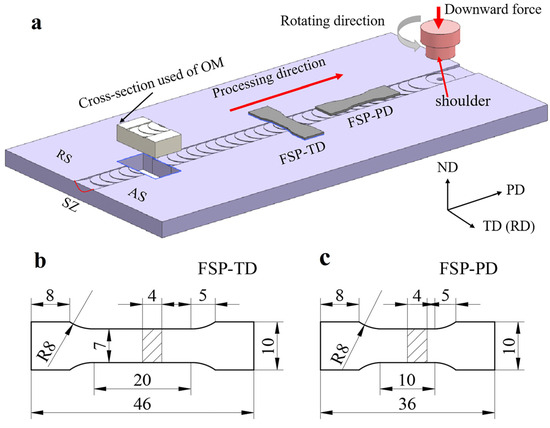
Figure 1

Journal Menu
► ▼ Journal Menu-
- Crystals Home
- Aims & Scope
- Editorial Board
- Reviewer Board
- Topical Advisory Panel
- Instructions for Authors
- Special Issues
- Topics
- Sections & Collections
- Article Processing Charge
- Indexing & Archiving
- Editor’s Choice Articles
- Most Cited & Viewed
- Journal Statistics
- Journal History
- Journal Awards
- Society Collaborations
- Conferences
- Editorial Office
Journal Browser
► ▼ Journal BrowserHighly Accessed Articles
Latest Books
E-Mail Alert
News
Topics
Topic in
Crystals, Entropy, Materials, Metals, Nanomaterials
High-Performance Multicomponent Alloys
Topic Editors: Xusheng Yang, Honghui Wu, Wangzhong MuDeadline: 29 February 2024
Topic in
Catalysts, Coatings, Crystals, Nanomaterials, Surfaces
Surface and Interface Engineering in Catalytic and Optoelectronic Applications
Topic Editors: Wei-Chun Chen, Shou-Yi Kuo, Cheng-Ying Chen, Li-Syuan Lu, Kun-An Chiu, Che-Chin ChenDeadline: 10 March 2024
Topic in
Alloys, Coatings, Crystals, Materials, Metals
Microstructure and Properties in Metals and Alloys, 2nd Volume
Topic Editors: Andrea Di Schino, Claudio TestaniDeadline: 31 March 2024
Topic in
Applied Sciences, Crystals, J. Compos. Sci., Materials, Metals
Modern Material Technologies Intended for Industrial Applications
Topic Editors: Tomasz Tański, Andrzej N. Wieczorek, Marcin StaszukDeadline: 30 June 2024

Conferences
Special Issues
Special Issue in
Crystals
Applications of Phononic Crystals & Acoustic Metamaterials
Guest Editors: Zhimiao Yan, Ting TanDeadline: 20 January 2024
Special Issue in
Crystals
Different Kinds of Hydrogen Bonds in Crystal Structures
Guest Editors: Magdalena Małecka, Lilianna ChecinskaDeadline: 31 January 2024
Special Issue in
Crystals
Synthesis, Characterization and Application of Novel Nanoparticles
Guest Editors: Fedlu Kedir Sabir, Osman Ahmed Zelekew, Bedasa Abdisa Gonfa, Lemma Teshome Tufa, Noto Susanto Gultom, Andebet Gedamu TamiratDeadline: 15 February 2024
Special Issue in
Crystals
Advanced Research of Oxide Thin Film Transistors
Guest Editors: Jorge Martins, Joana Dória Vaz PintoDeadline: 29 February 2024
Topical Collections
Topical Collection in
Crystals
Reviews in Liquid Crystals
Collection Editors: Vladimir Chigrinov, Aleksey Kudreyko
Topical Collection in
Crystals
Review Collections on Hybrid and Composite Crystalline Materials
Collection Editor: Leonid Kustov
Topical Collection in
Crystals
Review Papers in Microstructures of Alloys
Collection Editor: Cyril Cayron











